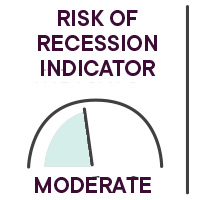The Fed, inflation and a new variant
What moved the markets in November:
- Jerome Powell was reappointed as head of the U.S. Federal Reserve (Fed), which was viewed positively by the markets.
- The markets reacted negatively, however, to Mr. Powell’s statement that inflation is no longer transitory, as well as to the emergence of the Omicron variant in many parts of the world.
Focus on the past month

Overview of global equity markets*
- The flagship index of the Canadian stock market, the S&P/TSX, fell 1.6% in November.
- In the United States, the S&P 500 gained 2.7% and the Nasdaq, 3.8%.
- International stock markets ended the month in negative territory, with the EAFE Index losing 1.4%.
- Emerging market equities were off 0.8% in November, while Chinese stocks were down 2.6%.
* All the percentages in this section are in Canadian dollars. Bloomberg unless otherwise indicated.
Key events

The Fed still in the headlines
While other candidates were more concerning, the markets were relieved to learn of Jerome Powell’s nomination as Fed chair for a second term.
In a speech on November 30, Mr. Powell conceded that the word “transitory” should no longer be used to describe current inflation and that labour and supply chain issues were still present.
Monetary policies and policy rates
As part of the tapering of its monetary easing program, the U.S. central bank had already initiated a reduction in its monthly bond purchases of $120 billion in November. Persistent inflation could prompt the Fed to accelerate its purchase reduction program. Already down to $15 billion per month, this reduction could be stepped up as the economy no longer needs such monthly injections of liquidity.
As for discussions on the next policy rate hikes, the Fed suggested that these rate increases could be moved up to 2022 or 2023 if the economy continues to grow. These comments were viewed negatively by the markets.
In Canada, the market expects policy rate hikes in the first half of 2022, if current conditions persist.
The many faces of COVID-19
The emergence in South Africa of the new Omicron variant, one of the mutations of the COVID-19 virus, made headlines in many countries. However, its speed of spread and the severity of the disease it causes are still under study by medical authorities.
Uncertainty about the effectiveness of vaccines and other treatments used to counteract previous variants is causing concern in the markets. This unpredictability translated into a significant drop at the end of the month.
Employment
Since September, the number of jobs in Canada has returned to pre-COVID levels. In November, 153,700 jobs were created, well above the expected 37,500. The unemployment rate fell from 6.6% to 6.0%, while the labour force participation rate was 65.3%, unchanged from the previous month.
As for employment in the United States, 210,000 jobs were created versus expectations of 550,000. The unemployment rate fell from 4.5% to 4.2%, while the labour force participation rate rose to 61.8%.
Results – Canadian bonds
Government of Canada bonds across maturities posted a positive return of 0.8% for the month. Year to date the return is -3.7 %. (Source: Canaccord Genuity)
Performance of our funds
View the returns

Our strategic monitoring
Main risks
Here are some risks that we are closely monitoring in the current environment.
- Global supply chains are experiencing disruptions which, if they continue for several more months, could cause a rise in inflation and reduce the production of goods and services, provoking an episode of stagflation.
- A rapid, sharp rise in interest rates would reduce the price/earnings ratio, which would cause stock indices to fall.
- A new Covid-19 variant could trigger a global economic slowdown, as could the current energy crisis in Europe and China.
- A major cyberattack could dampen the positive sentiment generated by the reopening of the global economy and the high level of consumer confidence.
- Governments could significantly increase corporate and personal tax rates to replenish their coffers. This scenario, highly unlikely in 2022 or 2023, would, however, imply the end of the pandemic.
Fundamental indicators
Some economic indicators we continued to follow in November.
Consumer confidence ![]()
Consumer confidence remained solid in November.
U.S. personal savings ![]()
The personal savings rate remains high but has been declining in recent months as temporary employment insurance programs have now ended.
Global Purchasing Managers’ Index ![]()
The index remains above 50, indicating an increase in purchasing managers’ intentions. The index is now at 54.2, in line with October’s number. Purchasing managers’ intentions continue to be positive, particularly in developed countries (56.9), compared to emerging economies (51.2).
Benchmark rates in Canada, Europe and the United States ![]()
Policy rates remain favourable for an economic recovery, but encouraging employment and inflation numbers in North America will prompt the Bank of Canada and the Fed to raise their respective policy rates probably sooner rather than later in 2022.
As for Europe, there are no plans yet to raise policy rates and it may be a while before we see a rate hike, since the recovery is weaker.
 |
 |
|
François Landry, CFA |
Yann Furic, B.B.A., M.Sc., CFA |
Sources: Bloomberg
The opinions expressed here and on the next page do not necessarily represent the views of Professionals’ Financial. The information contained herein has been obtained from sources deemed reliable, but we do not guarantee the accuracy of this information, and it may be incomplete. The opinions expressed are based upon our analysis and interpretation of this information and are not to be construed as a recommendation. Please consult your Wealth Management Advisor.









